![]() 1st Battalion 22nd Infantry
1st Battalion 22nd Infantry ![]()
Gunboats on Lake Lanao 1904-1905
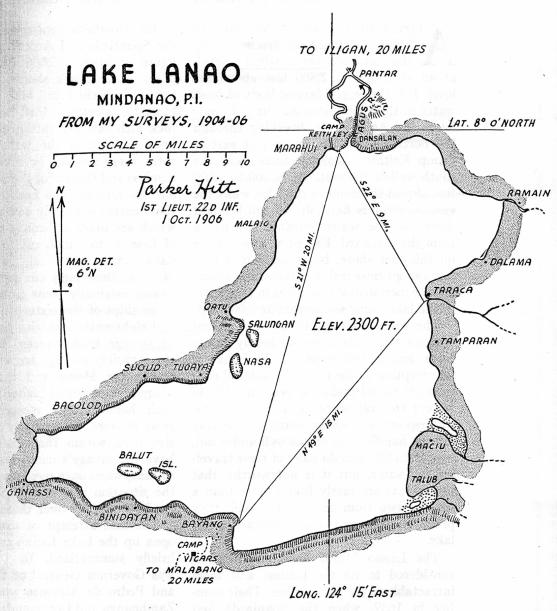
Map of Lake Lanao drawn by 1st LT Parker Hitt of the 22nd Infantry
From Amphibious
Infantry A Fleet On Lake Lanao by Colonel Parker
Hitt,
US Naval Institute Proceedings 1938
The following article
appeared in the US Naval Institute Proceedings,
February 1938.
It was written by Parker
Hitt, who, as a 1st Lieutenant in the 22nd Infantry,
was instrumental in raising the sunken Spanish gunboats General
Almonte and Lanao
from the bottom of Lake Lanao, on the island of Mindinao, 33 to
34 years earlier.
Thanks to Robert A. Fulton, the author of:
MOROLAND
The History of Uncle Sam and the Moros
1899-1920
for submitting the article to the 1st Battalion website.
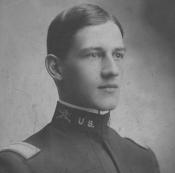
Parker Hitt, as a young Infantry Officer
From the Parker Hitt photograph collection, University of Michigan
AMPHIBIOUS INFANTRY
A FLEET ON LAKE LANAO
By COLONEL PARKER HITT, U.S. Army (Retired)
A little to the west of the
center of Mindanao lies Lake Lanao, filling the crater of a vast,
extinct volcano at an elevation of 2,300 feet above sea level.
It is the second largest body of fresh water in the Philippines
and its only outlet is the Agus River, breaking through the north
wall of the crater
just east of Camp Keithley. Twenty miles away the south wall of
the crater rises 800 to 1,000 feet almost sheer out of the lake,
while the eastern shore
is flat, alluvial soil brought down by the many streams flowing
in from the eastward. Except at some places on this east shore,
boats drawing 4 to 6 feet
can go close inshore almost anywhere. Some experimental soundings
in the center of the lake found no bottom at 1,000 feet. The wind
is always tricky,
and violent at times, over waters surrounded by mountains, and in
this respect Lake Lanao is no exception to the rule. The rainfall
runs from 60 to 80
inches a year, mostly in violent tropical showers, and formidable
waterspouts are not uncommon. The lake natives handle their
vintas well under sail,
oar, or paddle and do most of their traveling by water, but it is
noteworthy that their boats are rarely found more than a mile or
two from shore.
As a rule, they prefer to go around rather than across the lake.
The Lanao Moros have always been
considered to be the wildest and most intractable of the Moro
tribes. Their number in 1639,
when the Spaniards first reached the lake, is not known but there
were settlements all around its shores. At the end of the
nineteenth
and beginning of the twentieth centuries, estimates by the
Spaniards and Americans agree on a figure of about 15,000 living
within 5 miles
of the lake's shores. There are no towns; each chief and man of
any importance has a cotta or fort, built of earth or rock with
bamboo, rattan vines,
and even trees growing in the walls, and in this cotta there are
one or several houses of bamboo and thatch for the man, his wives
and his retinue.
The heavy armament of these cottas is usually several
"lantakas" which are brass or bronze muzzle-loaders of
from 1- to 3-inch caliber, loaded with nails,
scraps of metal, or even stones. Many of these guns are genuine
antiques, having originally come from Spanish and other ships of
the sixteenth,
seventeenth, and eighteenth centuries as piratical loot or
salvage from wrecks. Small arms of every variety and age are
widely scattered among the Moros
and the twisted kris (dagger) and broad-bladed kampilan are their
hand-to-hand weapons. They are good fighters, particularly on the
defensive
from within their cottas, and they have the savage's usual
respect for force so that, when once overcome, they accept the
situation
and make no more trouble until the control over them weakens.
The first attempt of the
Spaniards to open up the Lake Lanao country may be briefly
summarized. In 1639, Corcuera was Governor General
of the Philippines and Pedro de Almonte was Governor of Zamboanga
and Commandante General of the Islands of the South. They were
both
energetic soldiers of the type that had made Spain mistress of
new worlds, and rumors of the great lake in the center of
Mindanao were enough
for them to give orders for an expedition to investigate,
conquer, and Christianize the place. The force of about a
thousand, under the joint command
of Francisco Atienza, an experienced soldier, and Fr. Agustin de
San Pedro, a fighting priest, made its way up to Lake Lanao from
the north
carrying six boats "which were carried cut in four pieces
with such skill that they could be easily assembled for
launching." On April 4 they set foot
on the margin of the lake without having any trouble. They
assembled their six sectional boats and by land and water marched
right around the lake,
receiving the surrender of the various chiefs and holding
ceremonies of allegiance "in which they enrolled more than
2,000 families."
The priest wanted to put a permanent garrison in a fort on the
lake but the native troops would not consider the idea and the
expeditionary force
returned to their seacoast towns after a pleasant three months'
jaunt. Later that year another expedition from the south coast
marched through
the lake district without resistance from the inhabitants and
reached the north coast at Iligan.
Governor Corcuera in Manila,
after hearing the reports of these expeditions, ordered Bermudez
de Castro with 50 Spaniards and 500 native troops
from Bohol to go up to the lake, build a fort, and garrison it.
The lake Moros by this time were thoroughly aroused and organized
and from the very beginning of its construction the fort was
besieged and attacked. A relief column, commanded by the
redoubtable
Fr. Agustin de San Pedro, rescued the garrison from certain
extermination. Both commanders saw that the fort could not be
maintained
against the hordes of Moros who were bent on its destruction, so
they demolished what they had built with so much labor and
bloodshed
and retreated to Iligan on the north coast. The detachment was
there provisioned and returned to Bohol and Manila.
It is almost unbelievable, but after these expeditions of 1639
and 1640 no Spaniard laid eyes on Lake Lanao for more than 250
years.
The seat of Spanish authority in
Mindanao was at Zamboanga all these years, but every attempt to
Christianize even the coast town Moros
was a failure and their allegiance to the Spanish crown was
purely nominal. After 1880, the Manila government began to plant
colonies
of Christian Filipinos from the northern islands at points on the
north coast of Mindanao, with the idea of cutting off the sea
raids
of the piratical Moros which had occasionally even reached Luzon.
The plan, in conjunction with a naval patrol of the coast,
was reasonably successful but was hard on the colonists for the
Moros turned on them instead. The colony at Iligan, 25 miles
north of Lake Lanao,
suffered especially from the bold raids of the Lanao Moros. The
Manila authorities finally decided that the raiding would have to
be stopped
or the colonizing plan would have to be given up. An expedition
against the Lake Lanao Moros appeared to be the solution.
Plans for this expedition were
formulated in 1894, under the direction of Governor General Ramon
Blanco. As a part of the plans,
contracts were let in Hongkong for the construction of two steel
gunboats. They were to be shipped in pieces of the least possible
weight,
to permit of their transportation to Marahui on the lake, and
were there to be assembled by the constructing firm with their
engineers and personnel.
They were to have a speed of 10 miles per hour and capacity for
transporting 80 men. Their armament, contracted for with
Nordenfelt of London,
consisted of a 42-mm. rapid fire gun in the bow, two 11-mm.
machine guns amidships, and one 25-mm. machine gun, firing steel
projectiles, in the stern.
They were 92 feet long, 15 feet beam and drew 6 feet, and had a
single Scotch boiler and twin screws, each driven by a compound
noncondensing engine.
The powerful and well-equipped
expedition reached Marahui on Lake Lanao in March, 1895, after
severe fighting and heavy losses in personnel.
There was little further trouble with the Moros living along the
Iligan-Marahui trail but those who lived in the settlements
around the lake
continued their defiance and their attacks on the invaders. The
work of fortification was begun, as well as the construction of a
broad
and unobstructed road from the coast to Marahui. For the purpose
of transporting the sectional gunboats to the lake, there were
available
some 2,000 cargadores who were paid at the rate of a half peso a
day. The task of transporting the parts of the gunboats,
assembling them,
and launching them in the waters of the lake was directed by Sr.
Bringas, Naval Engineer of the Spanish Fleet. The construction
company
sent from Hongkong two English engineers and 100 Chinese workmen
for the assembly job.

The market place on the Lake at Marahui, early 1900's.
Photo from Amphibious
Infantry A Fleet On Lake Lanao by Colonel Parker
Hitt,
US Naval Institute Proceedings 1938
photo credit given as Colonel Parker Hitt
During the summer of 1895, a
further contract was let to the same firm in Hongkong for two
single-screw 65-foot gunboats
and three iron barges, each with a carrying capacity of 200 men.
This whole order was to be transported in pieces to Marahui
to be assembled and launched there. The barges were of an
excellent design for carrying troops for rapid disembarkation at
points on the lake shore.
They were 60 feet long, 20 feet beam, and drew but 2 or 3 feet of
water when loaded. They had a raised and decked-over forecastle
and a similar structure aft, while the midship section, about 40
by 20 feet, was fitted with removable benches and covered with an
awning.
They towed and handled well and could be maneuvered by man power,
for which oars and oarlocks in the rail were provided.
On August 18, 1895, the first of
the twin-screw gunboats was launched and, toward the end of
September, the second.
The trial trips gave all the results expected as to speed,
convenience, and maneuverability. The first warlike service of
the boats
was the reconnaissance carried out on October 16 to the south
shore of the lake and the bay of Ganassi by the Commanding
General in person,
accompanied by his Chief of Staff and the Division Commander. For
the next three months, combined action by land and water struck
terror
into the Moro tribes of the lake region. Their cottas were
attacked and destroyed, their movements on the lake were stopped
and, in general,
the operations were a complete success. The arrival and erection
of the two smaller gunboats and the three troop-carrying barges
during the winter
of 1895-96 gave the Spaniards such a preponderance of power on
the lake that they had no further serious trouble with the Moros
for the next three years.
The end of the Spanish
domination of Lake Lanao came as a result of the Spanish-American
War. Of the sinking of the fleet there is no record,
as far as can be discovered, but the facts as related some five
years later by Moro eyewitnesses are substantially as follows:
Some time in November,
1898, orders were received at Marahui for the post to be
abandoned and for the garrison to proceed to Iligan for
transportation to Zamboanga
and ultimately to Spain. As a result of these orders, the
garrison worked feverishly for three days, loading all
noninflammable stores and supplies
into the steel barges. They were particularly careful to remove
all metal objects, including the machine tools from the shops,
the contents
of the storehouses, and the rails and cars of a short section of
light railway which had been installed. The guns were removed
from the gunboats
and their bunkers were filled, about exhausting the stock of coal
ashore.
On the evening of the day when
this task was completed, the Moros saw steam being raised on one
of the larger gunboats
and about nine o'clock at night it pulled out from the dock with
the three other gunboats and the three barges in tow. Some hours
later
a single small boat carrying six men landed on the dock and went
into the guard's blockhouse. The post was put to the torch early
the next morning
and the garrison started on its march to Iligan to await its
ultimate return to Spain. The accuracy of this story is confirmed
by a singular bit of evidence.
Some seven years later, when we raised the Lanao, one of the
twin-screw gunboats, her boiler-room gratings were littered with
fire tools
and the remains of drawn fires and in the rack on the cabin table
were six champagne glasses and an empty champagne bottle.
I still have five of these glasses, mute witnesses to a hard task
well performed.
Except for the occupation of
Jolo and Zamboanga, the Americans did little in Mindanao until
1902. Events in the northern islands
required all available troops from 1898 until that year; the
Moros, no longer under Spanish discipline, followed their usual
line of action and,
after a time, began again to raid the settlements of the
Christian Filipinos along the Mindanao coast line. In 1902 the
28th Infantry
was sent to Iligan and had penetrated to Lake Lanao before the
year was out. The 14th Cavalry built a new post called Camp
Overton
just west of Iligan in 1903. That year, Major (now Lieutenant
General) Robert L. Bullard with the 28th Infantry and thousands
of natives
cut out the forest growth and rebuilt the old Spanish trail to
Lake Lanao so that it was passable for army wagons.
Early in December, 1903, the 22d
Infantry, in which I was a first lieutenant, relieved
the 28th Infantry. One battalion of the regiment
was stationed at Pantar at the bridge over the Agus River while
the rest of the regiment built Camp Keithley on the site of the
Spanish post.
The ruined boulder docks at the lake and road up to a lookout on
a hill were the visible remains of the Spanish occupancy.
One of the pressing needs of the garrison was water
transportation for use on lake. The 28th Infantry had built ten
crude flat-bottom boats
that would hold possibly ten men each but they were cranky and
unseaworthy. Nevertheless we used them and six or eight Moro
vintas
in the expedition against the Ramain River cottas in January,
1904, and again in the Taraca River expedition of April of that
year.
Captain Peter W. Davison (now deceased) was the Post
Quartermaster, charged with buying bamboo and other material from
the Moros
for building the new post, and he soon heard stories from them
about the fleet of gunboats that the Spaniards had sunk in the
lake.
One old Moro chief even had some marks on trees near his cotta at
Dansalan which he claimed gave intersecting lines of sight on a
point
where oil and floating debris had come to the surface after the
sulking. Following these clues and others, Captain Davison and
Lieutenants
Martin Novak and Dean Halford of the regiment finally got a
definite location of one of the boats about 2 miles south of the
dock in 90 feet of water.
This was on February 23, 1904, but much had to be done before any
use could be made of the find.
Ed., In his expeditions around
Lake Lanao in the fall of 1902 and early 1903, Captain John J.
Pershing
had previously marked down potential sites of the sunken boats.
¹
We finally got our first power
craft about the middle of April, after the Taraca expedition. It
was a 28-foot steam launch
(condemned, I always believed), off the Army hospital ship Relief,
then stationed in Manila. The hull came up the 2,800-foot climb
from Overton on an extemporized rig drawn by eight mules. Engine,
boiler, fittings, coal, and other supplies followed in other
wagons.
Within two days we had the Relief, as we always called
her, in the water with all machinery installed, all gadgets in
place,
and painted within an inch of her life. A formal trial trip,
planned for the next day, never came off for General Leonard Wood
arrived
and wanted to go across the lake so we just got up steam and
went. The littly hussy had a tricky water-tube boiler, a
compound,
condensing engine, and an unbelievable appetite for coal and
lubricating oil. After three years of hard and faithful service
her engine failed one day
as she was leaving the dock and she drifted onto the rocks at the
mouth of the swift Agus River and was hopelessly wrecked.
|
A 28-foot steam launch, of
the same type Photo from: |
Even before the Spanish gunboats
had been tentatively located, our need for at least one armed
vessel on the lake had been taken up
with Army Headquarters in Manila and early in May of 1904 it
arrived in boxes, bundles, and bales, accompanied by the erection
engineer
for the Shanghai builders, Mr. Turnbull, and 100 Chinese
laborers. This was the Flake, named after one of our
officers killed in action
in the Ramain expedition. She was 65 feet long, 12 feet beam, and
drew about 4 feet of water. We had already built and launched
two wooden decked barges for raising the Spanish boats, so there
was no delay in building ways for her erection and the work went
ahead fast
under Mr. Turnbull's able direction. She was launched on June 20
and had her trial trip on July 3. With her Scotch boiler and
compound
noncondensing engine she was a fine sturdy boat, well fitted for
the towing of barges and log rafts for our saw mill.
I mounted a Vickers Maxim 37-mm. automatic gun (pom-pom) in her
bow and a 45-caliber Gatling gun aft, and thus armed
she was the "Dreadnought" of the lake for many a month.
Her crew of five (all Manila Bay Filipinos) ran her under my
supervision
and kept her in apple-pie order, no matter what dirty work was
demanded of her.

The 65-foot gunboat Flake,
named after Lieutenant Campbell W. Flake of the 22nd
Infantry,
killed in action at Ramaien River, Mindanao, January 22, 1904.
At the bow can be seen the Vickers/Maxim 37mm automatic gun that
was mounted by Lieutenant Hitt.
Photo from the Parker Hitt photograph collection, University of Michigan
About this time the route by
road from Camp Overton to Camp Keithley, then by boat across Lake
Lanao to Camp Vicars,
and finally by road again to Malabang, became a well-traveled way
between Manila and Zamboanga and Jolo. We also had
a two-company garrison, frequently changed, at the mouth of the
Taraca River, and as soon as she was finished the Flake
immediately went
on a daily schedule to handle the traffic over the route
Marahui-Taraca-Bayang-Marahui.
One day in late September the
Commanding Officer sent for me and told me that the Sultan of
Oatu, who lived on a beautiful bay
of the same name, about halfway along the northwest shore of the
lake, had sent word that he had "a bad heart" for the
Americans
and that we had better keep away from his district. The C. O.
directed me to drop into the bay and see what would happen.
I took on nine picked rifle shots from the regiment in addition
to my Filipino crew of five, mounted a .30-caliber Colt machine
gun
in addition to the other armament and went to see. As the Flake
rounded the point to enter Oatu Bay, all was quiet ashore.
Then long, red Moro streamers broke out from poles around the
sultan's house and on the hillsides, and 50 or 60 riflemen let go
at the boat,
fortunately still about 600 yards away. Most of the shots fell
short but three hit the boat. They had little smokeless powder
and we went into action
at the clouds of white smoke ashore. Then from a stone fort high
on the hill and about 1,000 yards off came a shot from a 6-inch
muzzle-loading cannon that struck the water about 200 yards
beyond us. It was a kind of opera bouffé battle. We cruised
around
in the landlocked bay until all our ammunition was gone; the
Moros fired the big gun twice more but the last shot barely hit
the beach
from lack of powder. Their rifle and lantaka fire practically
ceased after the first few volleys. The net result was four hits
on the Flake;
one of our shells set fire to the sultan's house and we heard
later that two Moros had been wounded.
When I reported on our return,
the Commanding Officer was pretty mad. An expedition against Oatu
was in order and,
after some delays due to politics (it was an election year in the
United States), it was launched. The Flake towed a barge
full of troops down the lake; other troops, including a mountain
battery, closed in from the land side and the entire settlement
was destroyed
with numerous casualties; the survivors fled to the mountains
and, some weeks later, the sultan came in voluntarily and made
his peace
with the authorities. That was the last major trouble on Lake
Lanao for five years.
When the sunken Spanish boats
were located in February, 1904, Captain Davison immediately made
arrangements to salvage them if possible.
Early in March, Mr. Frederick J. Davies, an experienced deep-sea
diver, arrived to take technical charge of the job.
He was an Englishman, possibly 50 years old, whose proudest boast
was that he was one of the four divers who got the treasure
out of the Spanish liner Alfonso XII, sunk in 240 feet
of water in the Bay of Biscay. The other three divers died as a
result of their work;
Mr. Davies was still suffering with the "bends" brought
on by that hitherto unparalleled feat of deep-sea diving.
Two soldiers of the regiment,
one of whom had had experience in harbor diving, and a large
force of Filipino workmen formed Mr. Davies's crew.
They built two decked-over barges of wood for the work and
assembled a storehouse full of anchors, hawsers, winches, and a
thousand other things
that might be needed on the job. By April 26, all was ready and I
towed the barges out to the buoys marking the position of the
sunken boats.
Then followed a month of work getting the bow and stern lines
under one of them. The water was fresh but murky, so that at 90
feet there was no light;
also the bottom temperature ran from 80 to 90 degrees Fahrenheit,
owing to hot springs. There was no tide to lift the boat after
the slings were in place,
and that important part of the work had to be done by man power
through the medium of four big hand winches.
Late in May the southwest
monsoon began to blow and for days work was suspended and it
became a problem to get food to the guard
on the barges. It was not until July 19 that the lifting proces
was successful in raising the boat out of the mud. On the 23d she
was lifted 47 feet
and towed in 1¼ miles, when a tackle broke and she dropped about
5 feet onto jagged rocks. On August 3 the funnel appeared,
and by this time we knew that she was the General Almonte,
one of the single screw 65-footers.
I will not go into the details
of the troubles we had in getting the General Almonte
out of water and up on the ways. Sufficient to say
that it was October 14 before this part of the task was
completed. After that, her bottom had to be repaired, her
machinery had to be
completely overhauled, she had to be made livable again with new
carpenter work and paint and awnings, so that she was not
launched
until December 12. On the last day of 1904 she had her trial trip
and thereafter she ran regularly in the Marahui-Taraca-Bayang
service,
while the Flake towed logs and bamboo rafts for the
construction of the permanent quarters of Camp Keithley.
It was February 13, 1905, before
the necessary heavier equipment was assembled and the barges were
towed out to where the Lanao lay.
Mr. Davies had been down to look her over several times in pauses
in the work on the General Almonte and he and I both had
serious doubts
as to whether this 92-foot boat could be raised with our
available barges, but it was decided to try anyhow. She lay in 95
feet of water,
about 2 miles out in the lake. Within two months, slings had been
put under her and she had been raised 25 feet and moved in about
600 feet
by slow and cautious stages. At this point, Mr. Davies found the
way blocked by one of the 60-foot steel barges, loaded with the
contents
of the Spanish machine shop. He made a careful examination of it
and reported that it was in perfect condition, so work on the Lanao
was stopped for the time being and the lifting pontoons were
shifted to the sunken barge. It was our one easy job, for within
40 days
the barge was afloat and lying at the dock, undamaged after lying
at the bottom of the lake for 6½ years. The cargo included
quantities of light rails, some cars, machine tools, and shop
supplies that, in spite of their condition, were a welcome
addition to our limited stocks.
I remember particularly a box of gauge glasses for the boilers,
that being an item that we could not seem to get on requisition
from Manila.
When the barge was cleaned out
and painted, it made a fine addition to the fleet as it would
carry as many as 200 troops, it towed well,
and its light draft made it possible to beach it almost anywhere
around the lake so that the men did not have to be landed in
small boats.
Also Mr. Davies had an eye on it for possible use in case his
pontoons would not give the final lift to the Lanao.
After the barge was out of the way,
work on the Lanao was resumed and by using the last inch
of displacement on the pontoons she was finally brought to the
dock head
with her rail out of water. That was on September 25, but during
the night a gale blew up, the port pontoon sunk under its load,
and the whole job
was just an ugly wreck by morning. Fortunately we could work, in
part, from the dock, so that the Lanao was finally free
and afloat within ten days.
Her bottom was undamaged, the only underwater damage being a bent
blade on the starboard propeller which had to be removed for
straightening.
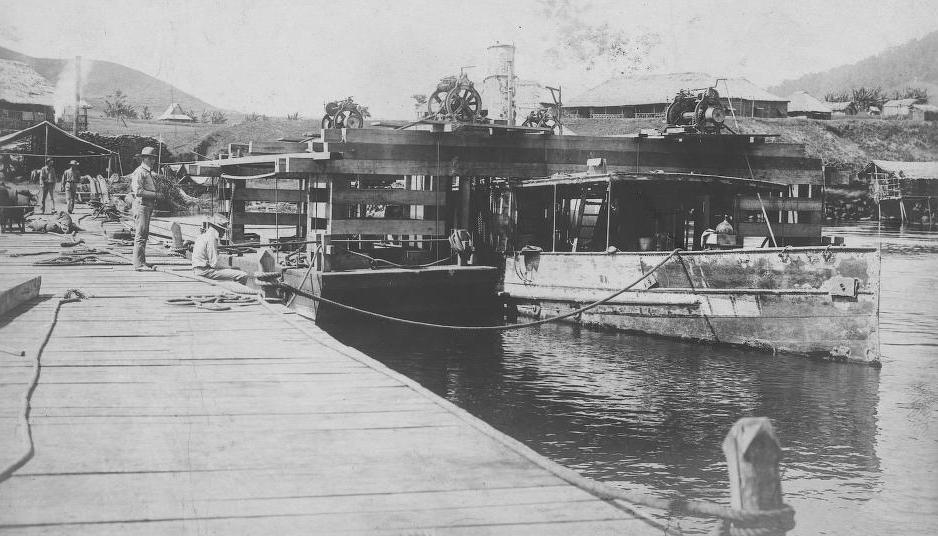
The Lanao,
after being raised and refloated. The two barges are still on
either side of the Lanao,
and all four hand-cranked winches used to raise her can be seen.
Photo from the Parker Hitt photograph collection, University of Michigan
Mr. Davies went off for a long
delayed vacation and rest after the Lanao was floated
but the next three weeks were very strenuous for the rest of us.
For some reason that has slipped my mind the Commanding Officer
wanted her ready by November 1, so work went on day and night.
The mud was removed from the hull and it was painted with red
lead inside and out; both engines were taken down and all pits
and grooves
in the moving parts made good with babbitt metal; all gaskets for
engines, pumps, boiler, and sea valves were replaced with new
ones cut out by hand;
all decks, cabins, and other woodwork were overhauled; the awning
stanchions were straightened and new awnings made and stretched;
the steering gear from wheel to rudder was put in order; the
davits were replaced and two new boats slung on them; and finally
the boiler was tested to 150 lb. cold, steam was raised, and the
engines turned over. The guns had been removed by the Spaniards
and we had nothing to go on the gun mounts except a Vickers Maxim
37-mm. automatic, but that was duly mounted.
For days we had been looking for
a shipment of white paint to cover the glaring first coat of red
lead. By October 25, all else was ready
but the paint had not arrived, so we decided to have the trial
trip the next day, paint or no paint. It was an entire success in
every way.
When the Moros saw the resurrected Lanao steaming down
the lake, painted in the Moro war color, and heard her gun being
fired,
they took to the hills by the hundreds. The Civil Governor of the
Moro Province had to send out special couriers to assure his
people
that they would not be wantonly attacked, but it was not until
the Lanao was painted white a week later that they felt
safe again.
The 15th Infantry relieved the
22d Infantry in December of 1905 and I turned over the fleet to
my old friend, 1st Lieutenant A. Owen Seaman
of that regiment, now Brigadier General, Assistant to the
Quartermaster General. I stayed on for a month after my regiment
left, to show him the ropes,
and then returned to the United States.
During the next two years all
the rest of the sunken Spanish boats were raised under Lieutenant
Seaman's supervision. First the two other steel barges,
which had already been located, were floated and then these
barges were used to raise the General Blanco, a
twin-screw sister-ship to the Lanao.
The General Blanco, through a combination of luck and
skill gained by experience, came up in perfect condition as to
hull, machinery, and fittings.
She was in running order before the end of 1906 was armed with a
42-mm rapid-fire gun forward, a 37-mm automatic aft, and five
30-caliber
Maxim machine guns amidships and on the upper deck. She became
the one "battleship" of the fleet and served honorably
in the Sauir
and Malaig expeditions against Datu Ami Binaning in 1907. A good
ship, for after 12 years' service as a fighting craft, she was
turned over
to the Provincial Government of Lanao in 1918 and still continues
to make bi-weekly trips around the lake in this year 1938.
She is the only one of the fleet still afloat and running.
The last of the sunken fleet to
be was the Corcuera, 65-foot sister-ship to the General
Almonte. She was never put in running order
on account of serious damage to her rudder and propeller which
happened when she went down. Also, by that time,
the Army had all the Navy that it needed on the lake to keep the
peace.
Thirty years have passed since
those days but the Lanao Moros are still a problem for the
Philippine government. Only last April
a band of Moro outlaws intrenched themselves in Cotta Macaguiling
between Binidayan and Ganassi on the south shore of the lake
and proceeded to terrorize the inhabitants of the vicinity. The
garrison of the new Philippine Army at Camp Keithley organized an
expedition,
embarked it on the faithful General Blanco and proceeded
to the south shore where they landed and abolished the gang and
the cotta with trench mortar fire.
Times change; the Moros remain Moros.
**********************
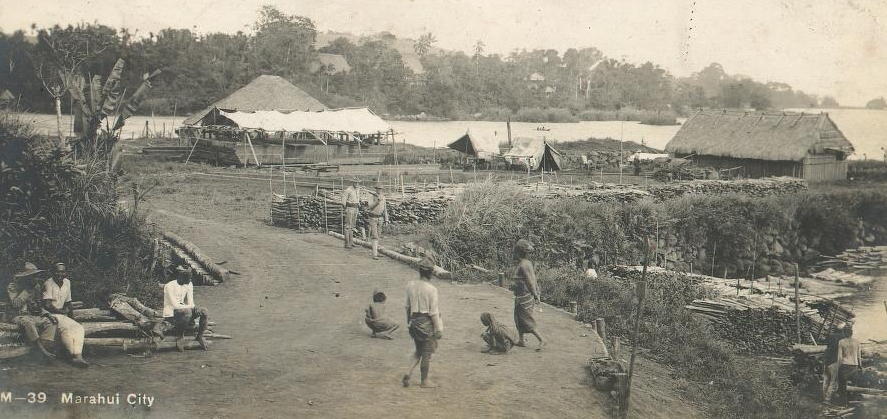
The dock and guardhouse area at Marahui
on Lake Lanao.
Under the light-colored canvas cover are the two barges used in
the raising of the sunken Spanish gunboats.
Note the two Soldiers of the 22nd Infantry guarding the bridge to
the area.
Photo from the Parker Hitt photograph collection, University of Michigan
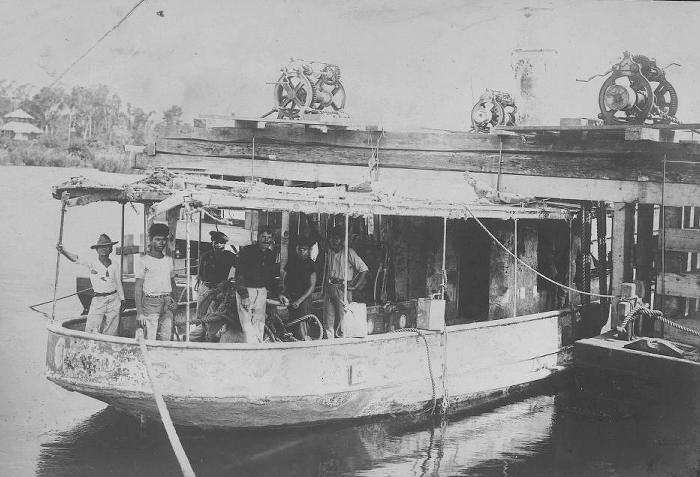
The stern end of the Lanao,
with workers aboard.
The boat is still connected to the winching system by which she
was raised.
Note the handles for cranking the winches; one on each side, two
men cranking each winch at the same time.
Photo from the Parker Hitt photograph collection, University of Michigan
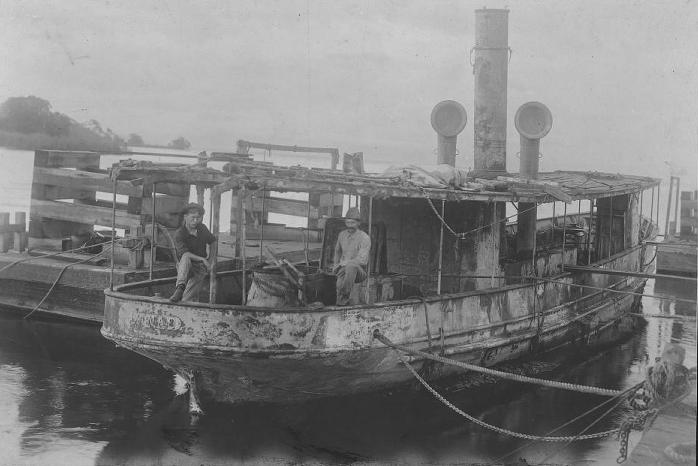
Stern view of the Lanao, after the winching system had been disconnected.
Photo from the Parker Hitt photograph collection, University of Michigan
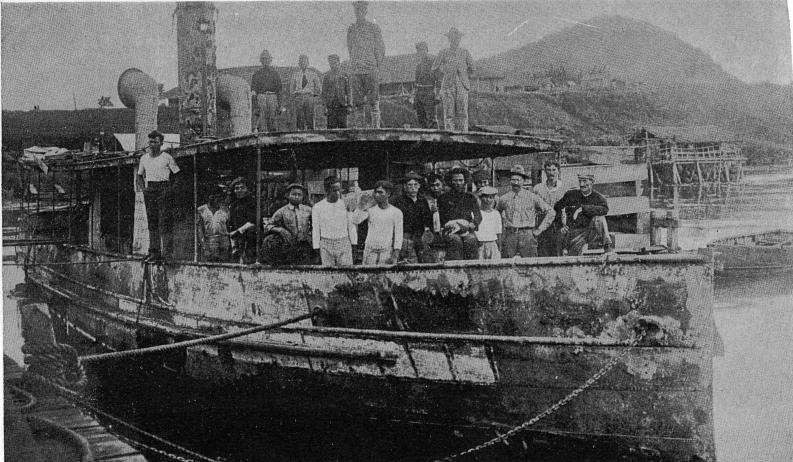
Bow view of the Lanao, prior to being refitted and repainted.
Photo from Amphibious
Infantry A Fleet On Lake Lanao by Colonel Parker
Hitt,
US Naval Institute Proceedings 1938
photo credit given as Colonel Parker Hitt
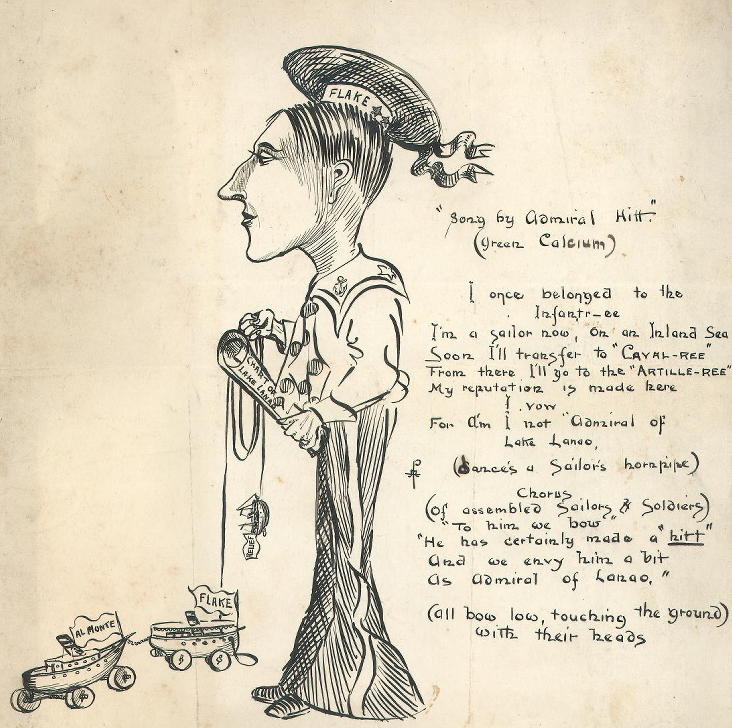
Caricature of Lieutenant Parker Hitt,
being portrayed as "Admiral of Lake Lanao".
Note that his toy boats include the Almonte,
Flake and Relief.
Illustration from the Parker Hitt photograph collection, University of Michigan
¹ Robert Fulton, author of MOROLAND The History of Uncle Sam and the Moros 1899-1920
**********************
Home | Photos | Battles & History | Current |
Rosters & Reports | Medal of Honor | Killed
in Action |
Personnel Locator | Commanders | Station
List | Campaigns |
Honors | Insignia & Memorabilia | 4-42
Artillery | Taps |
What's New | Editorial | Links |